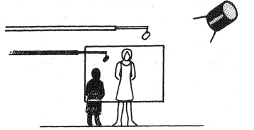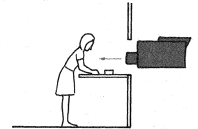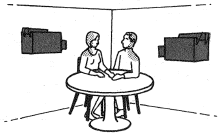The Aims of Lighting
Lighting Problems
Effective television production is based on teamwork. One person’s dilemma can often only be solved by another’s action.
Lighting and sound
Sound booms cast shadows. The trick Is to angle the key light so that these shadows are thrown out of shot, and not onto the talent or nearby scenery. When shadows do appear in shot, there are several solutions:
• Position the mike further away from the speaker.
•Reframe the shot so that the shadow is not seen.
•Take a closer shot.
•Hide the shadow in a dark area of the background.
•Reposition the key light or the talent.
•Use a soft (diffused) key light.
Shadows
Shadows are the essence of dynamic lighting. But when they fall in the wrong place, they can be extremely distracting.
•A heavy shadow beside a person standing near a wall. (Move them further from it, and angle the key.)
•A person’s shadow falls onto his neighbor’s face. (A slight head tilt or repositioning may cure the problem.)
• Someone’s shadow falls onto a map they are discussing. (Key from another direction; readjust their position.)
•The camera’s shadow falls onto the subject. (Raise the key; lower the camera; take camera further away.)
Subject position
It’s best to avoid placing people close to walls, right in the corner of a room, tucked behind a pillar, or underneath an overhanging feature (e.g. ceiling, arch, chandelier). These situations restrict lighting angles, and shadows may be difficult to avoid.
Overbright Surfaces
Excessively bright surfaces burn out as blank detailless areas in the picture, whether they are too light in tone, too shiny, or overlit. Sometimes it is possible to adjust the lighting, but you may need to:
• Substitute the article (e.g. use darker drapes instead).
• Darken with water-soluble spray, or dull with wax spray.
• Change the subject’s position (e.g. slightly angle or move it). •Cover over the bright area (e.g. hide a bad reflection).
• Remove the object altogether.
Precision lighting
Generally speaking, most lighting falls into two categories: general lighting, where we provide broad area treatment, which is modified where necessary to suit shots during rehearsal; and specific lighting, carefully angled and adjusted to suit particular planned shots.
The effect of light changes if you reposition or re-angle the subject or the camera. What was previously a frontal key can now become a side or back light! So major deviations from the originally planned shooting angles can produce unpredictable results. Revising the lighting treatment to compensate may upset earlier shots.

Boom shadows
Boom shadows will usually distract; particularly if they are moving or unsteady.

Subject positions
It is well to avoid positioning people beneath low ceilings.

Placed close to a camera trap, the camera can see, but lighting is difficult.

When people sit close to walls,or in the corners of rooms, close-shooting cameras may shadow them.

Lighting underneath arches and overhangs is often poor.
